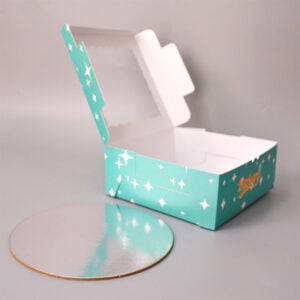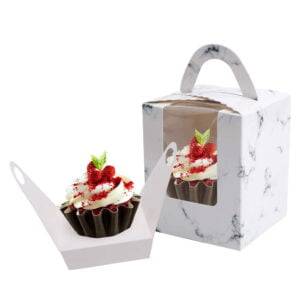Introduction
Cake box packaging is not just about presentation; it plays a crucial role in ensuring the safety and quality of the delicious cakes it holds. Whether you run a bakery or prepare cakes at home, understanding and implementing proper food safety measures in cake box packaging is essential. In this comprehensive guide, we will explore the key steps and best practices to guarantee food safety from the moment the cake is prepared to the moment it reaches your customer’s hands.
The Importance of Food Safety in Cake Packaging
Protecting Health
Food safety is paramount because improperly handled or packaged cakes can lead to foodborne illnesses, affecting the health of consumers.
Preserving Quality
Food safety measures not only protect health but also preserve the quality and taste of your cakes, ensuring they reach customers in the best possible condition.
Selecting Food-Safe Packaging Materials
Food-Grade Certification
Choose cake box packaging materials that are certified as food-grade. This certification ensures that the materials are safe for direct contact with food.
Avoiding Toxic Substances
Ensure that the cake box packaging materials do not contain any toxic substances or chemicals that can leach into the cake.
Proper Hygiene and Sanitization
 Handwashing
Handwashing
Maintain strict hand hygiene. Anyone handling cakes or cake box packaging should wash their hands thoroughly with soap and water before touching the cakes or packaging.
Sanitizing Work Surfaces
Regularly sanitize work surfaces, utensils, and equipment to prevent cross-contamination. Use food-safe sanitizers and follow manufacturer instructions.
Safe Cake Handling
Glove Usage
Consider using food-safe disposable gloves when handling cakes. Gloves can help prevent direct contact between hands and the cake, reducing the risk of contamination.
Cake Assembly
Ensure that the cakes are assembled in a clean and sanitized environment, using safe and hygienic practices.
Temperature Control
Proper Storage
Store cakes at the appropriate temperature to prevent bacterial growth. Refrigerate or freeze cakes when necessary, and monitor storage conditions.
Packaging Temperature
Ensure that cakes are adequately cooled before placing them in cake box packaging. Hot or warm cakes can create condensation inside the box, leading to moisture-related issues.
Moisture Management
Moisture-Resistant Packaging
Choose cake box packaging with moisture-resistant properties. This prevents moisture from the cake from being absorbed by the packaging, which can lead to sogginess or mold.
Drying Techniques
Before packaging, allow cakes with fillings or frostings to set and dry properly. This reduces the risk of smudging and sticking to the packaging.
Allergen Management
Ingredient Labeling
Clearly label cake box packaging with information about common allergens present in the cake. This helps customers with allergies make informed choices.
Cross-Contamination
Prevent cross-contamination of allergens by using separate utensils, workspaces, and packaging materials for cakes with allergenic ingredients.
Tamper-Evident Packaging
Sealing Integrity
Ensure that cake box packaging has tamper-evident features like seals or stickers that break upon opening. This reassures customers of the cake’s safety and integrity.
Visual Inspection
Perform visual inspections before sealing cake boxes to verify that cakes are in good condition and free from any foreign objects or contaminants.
Quality Assurance
Regular Training
Train your staff regularly on food safety protocols, including proper cake handling, packaging, and sanitation practices.
Quality Control Checks
Implement quality control checks to verify that cakes meet safety and quality standards before packaging and delivery.
Transportation Safety
Secure Packaging
Ensure that cake boxes are securely sealed and won’t tip over or shift during transport. This prevents cakes from getting damaged or contaminated during delivery.
Temperature Maintenance
If cakes need to be transported at specific temperatures, use insulated cake box packaging or cooling methods to maintain the required conditions.
Customer Education
 Packaging Information
Packaging Information
Include information on cake box packaging about safe handling, storage, and consumption of the cake. Educated customers are more likely to follow proper food safety practices.
Communication
Establish open communication with customers about any special handling or storage requirements for the cake once it’s delivered to their homes.
FAQ: Frequently Asked Questions
Q1. What are the signs that a cake may be unsafe to eat?
Signs of an unsafe cake include an off or unusual odor, visible mold, an unusual texture, or a sour or bitter taste. If you notice any of these, it’s best not to consume the cake.
Q2. Can I reuse cake box packaging for other purposes after I’ve received a cake?
You can reuse cake box packaging, but make sure it’s thoroughly cleaned and sanitized before using it for another purpose to avoid cross-contamination.
Q3. How do I handle cakes with fragile decorations to ensure they remain intact in the box?
Handle cakes with fragile decorations carefully. Use support structures if needed, and choose cake box packaging that provides ample space and protection for delicate decorations.
Q4. Are there any special considerations for shipping cakes to distant locations?
When shipping cakes, use sturdy cake box packaging designed for transportation. Consider expedited shipping to reduce the time the cake spends in transit.
Q5. Can I store cakes in the cake box packaging they came in?
You can store cakes in their original cake box packaging, but ensure that it’s airtight and moisture-resistant to maintain freshness.
Q6. What should I do if a customer reports an issue with a cake they received?
Address customer complaints promptly and professionally. Investigate the issue, offer a resolution, and take steps to prevent similar incidents in the future.
Conclusion
Ensuring food safety in cake box packaging is a critical responsibility for both bakeries and home bakers. By following proper hygiene, selecting food-safe materials, maintaining temperature control, and implementing quality control checks, you can guarantee that the cakes you prepare reach customers in perfect condition and are safe to consume. Additionally, effective customer education and communication play a crucial role in reinforcing food safety practices throughout the entire process, from packaging to consumption. Prioritizing food safety not only protects the health of your customers but also upholds the reputation of your bakery or home-based cake business.
 Handwashing
Handwashing Packaging Information
Packaging Information